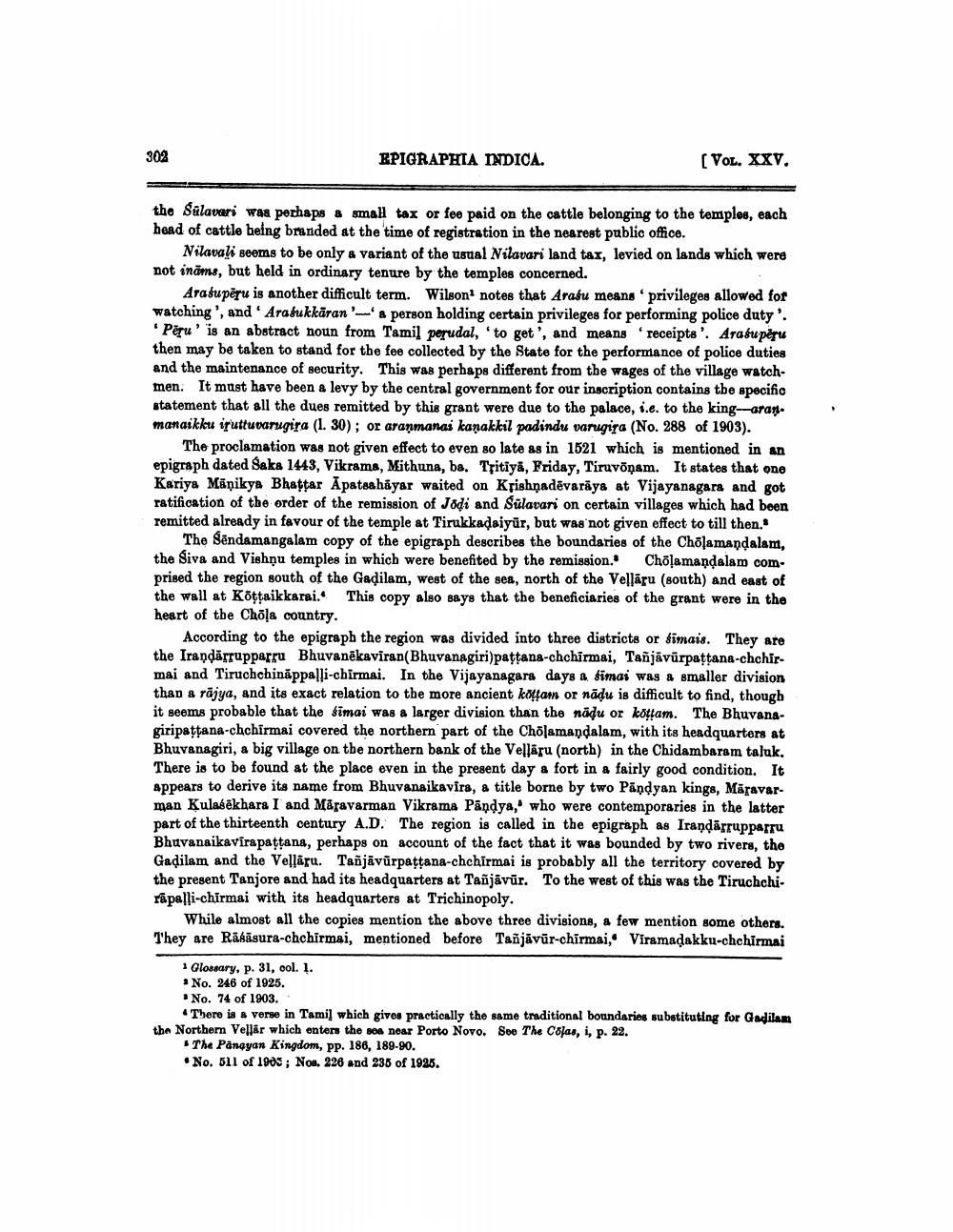________________
302
EPIGRAPHIA INDICA.
[VOL. XXV.
the Sulavari was perhaps a small tax or fee paid on the cattle belonging to the temples, each head of cattle being branded at the time of registration in the nearest public office.
Nilavali seems to be only a variant of the usual Nilavari land tax, levied on lands which were not inams, but held in ordinary tenure by the temples concerned.
Arasuperu is another difficult term. Wilson' notes that Araśu means ' privileges allowed for watching', and 'Arasukkaran'-' a person holding certain privileges for performing police duty'. 'Peru' is an abstract noun from Tamil perudal, to get', and means receipts'. Arasuperu then may be taken to stand for the fee collected by the State for the performance of police duties and the maintenance of security. This was perhaps different from the wages of the village watchmen. It must have been a levy by the central government for our inscription contains the specific statement that all the dues remitted by this grant were due to the palace, i.e. to the king-aran. manaikku iruttuvarugira (1. 30); or aranmanai kanakkil padindu varugira (No. 288 of 1903).
The proclamation was not given effect to even so late as in 1521 which is mentioned in an epigraph dated Saka 1443, Vikrama, Mithuna, ba. Tritiya, Friday, Tiruvonam. It states that one Kariya Manikya Bhaṭṭar Apatsahāyar waited on Krishnadevaraya at Vijayanagara and got ratification of the order of the remission of Jodi and Sulavari on certain villages which had been remitted already in favour of the temple at Tirukkadaiyür, but was not given effect to till then."
The Sendamangalam copy of the epigraph describes the boundaries of the Chōlamanḍalam, the Siva and Vishnu temples in which were benefited by the remission. Chōlamandalam comprised the region south of the Gaḍilam, west of the sea, north of the Vellaru (south) and east of the wall at Köṭṭaikkarai. This copy also says that the beneficiaries of the grant were in the heart of the Chōla country.
According to the epigraph the region was divided into three districts or simais. They are the Iranḍärrupparru Bhuvanēkaviran (Bhuvanagiri)paṭṭana-chchirmai, Tañjavürpaṭṭana-chchirmai and Tiruchchinäppalli-chirmai. In the Vijayanagara days a simai was a smaller division than a rajya, and its exact relation to the more ancient kottam or nadu is difficult to find, though it seems probable that the simai was a larger division than the nadu or köttam. The Bhuvanagiripaṭṭana-chchirmai covered the northern part of the Chōlamandalam, with its headquarters at Bhuvanagiri, a big village on the northern bank of the Vellaru (north) in the Chidambaram taluk. There is to be found at the place even in the present day a fort in a fairly good condition. It appears to derive its name from Bhuvanaikavira, a title borne by two Pāṇḍyan kings, Märavarman Kulasekhara I and Maravarman Vikrama Pandya," who were contemporaries in the latter part of the thirteenth century A.D. The region is called in the epigraph as Iranḍārrupparru Bhuvanaikavīrapaṭṭana, perhaps on account of the fact that it was bounded by two rivers, the Gadilam and the Vellāru. Tañjāvürpaṭṭana-chchirmai is probably all the territory covered by the present Tanjore and had its headquarters at Tañjāvūr. To the west of this was the Tiruchchirapalli-chirmai with its headquarters at Trichinopoly.
1 Glossary, p. 31, col. 1.
No. 246 of 1925.
While almost all the copies mention the above three divisions, a few mention some others. They are Rakasura-chchirmai, mentioned before Tañjāvür-chirmai, Viramaḍakku-chchirmai
No. 74 of 1903.
There is a verse in Tamil which gives practically the same traditional boundaries substituting for Gadilam the Northern Vellar which enters the sea near Porto Novo. See The Colas, i, p. 22.
The Panayan Kingdom, pp. 186, 189-90.
No. 511 of 1903; Nos. 226 and 235 of 1925.




